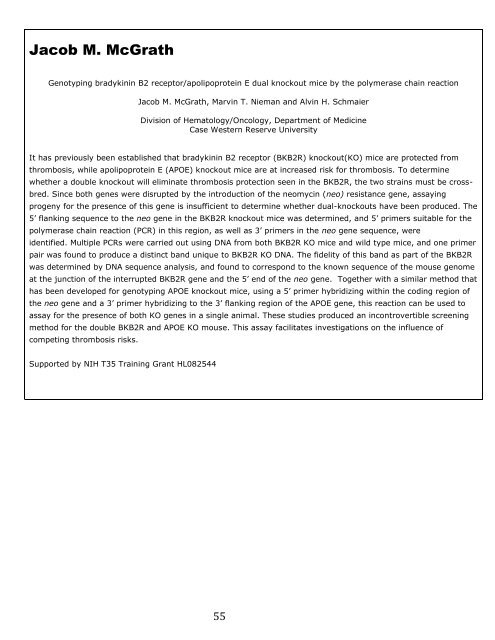student research day - Case Western Reserve University School of ...
student research day - Case Western Reserve University School of ...
student research day - Case Western Reserve University School of ...
You also want an ePaper? Increase the reach of your titles
YUMPU automatically turns print PDFs into web optimized ePapers that Google loves.
Jacob M. McGrath<br />
Genotyping bradykinin B2 receptor/apolipoprotein E dual knockout mice by the polymerase chain reaction<br />
Jacob M. McGrath, Marvin T. Nieman and Alvin H. Schmaier<br />
Division <strong>of</strong> Hematology/Oncology, Department <strong>of</strong> Medicine<br />
<strong>Case</strong> <strong>Western</strong> <strong>Reserve</strong> <strong>University</strong><br />
It has previously been established that bradykinin B2 receptor (BKB2R) knockout(KO) mice are protected from<br />
thrombosis, while apolipoprotein E (APOE) knockout mice are at increased risk for thrombosis. To determine<br />
whether a double knockout will eliminate thrombosis protection seen in the BKB2R, the two strains must be cross-<br />
bred. Since both genes were disrupted by the introduction <strong>of</strong> the neomycin (neo) resistance gene, assaying<br />
progeny for the presence <strong>of</strong> this gene is insufficient to determine whether dual-knockouts have been produced. The<br />
5’ flanking sequence to the neo gene in the BKB2R knockout mice was determined, and 5’ primers suitable for the<br />
polymerase chain reaction (PCR) in this region, as well as 3’ primers in the neo gene sequence, were<br />
identified. Multiple PCRs were carried out using DNA from both BKB2R KO mice and wild type mice, and one primer<br />
pair was found to produce a distinct band unique to BKB2R KO DNA. The fidelity <strong>of</strong> this band as part <strong>of</strong> the BKB2R<br />
was determined by DNA sequence analysis, and found to correspond to the known sequence <strong>of</strong> the mouse genome<br />
at the junction <strong>of</strong> the interrupted BKB2R gene and the 5’ end <strong>of</strong> the neo gene. Together with a similar method that<br />
has been developed for genotyping APOE knockout mice, using a 5’ primer hybridizing within the coding region <strong>of</strong><br />
the neo gene and a 3’ primer hybridizing to the 3’ flanking region <strong>of</strong> the APOE gene, this reaction can be used to<br />
assay for the presence <strong>of</strong> both KO genes in a single animal. These studies produced an incontrovertible screening<br />
method for the double BKB2R and APOE KO mouse. This assay facilitates investigations on the influence <strong>of</strong><br />
competing thrombosis risks.<br />
Supported by NIH T35 Training Grant HL082544<br />
55
















